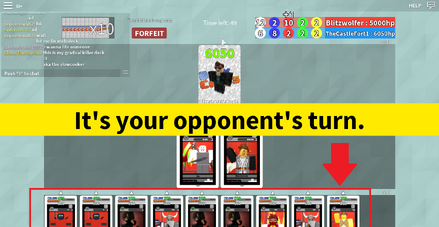
Highlighted in red is the user's hand.
The hand is where you store cards in a match before they are summoned. In a match, both players start with 7 cards already drawn and naturally draw one card at the start of the turn. Technically, you will have 8 cards in your hand at the start of the first turn.
You can only have a maximum of ten cards in your hand at a time. When you draw a card with a full hand, the drawn card gets destroyed. The same happens if you are given cards by a fighter, terrain, or action with a full hand.
Mulligan System[]
When the game starts, the game uses a mulligan system to reduces the chance of your hand bricking. This is done in order to help noobs and veterans alike be more consistent.
The mulligan system consists of drawing two hands, then counting the number of cards in each hand with an exact cost of 1-4 colourless studs. The hand with the number of those 1-4 colourless costed cards closest to 2 is your hand and the other one gets shuffled back in.
Reveal[]
A hand can be revealed. Reveal causes the hand to show what cards you have to the opposing player. For example, Eye Spy shows the opponent's hand. While revealing is not very effective in terms of gameplay, revealing gives you information to use. That information may include:
- What is the deck's win condition?
- What does the opponent have that is summonable?
- What threats does the opponent have in the hand?
- What will the opponent will do next?
Using this information, you might work around the opponent to give you a strategic advantage.
A fighter might be returned to the hand. When a fighter is returned, the fighter will have its current stats when it was returned, along with the amount of turns it is locked. To summon it again, you need to spend icons.
Using the hand to your advantage[]
A match does not take place on just the board. It can also affect other factors as well. The hand is one of them.
Here are the ways you can manipulate you or your opponent's hand into your advantage.
- Nightmares: Nightmares are actions that cannot be discarded and have negative effects when cast. These cards also take up space in the hand. While this may seem useless, having too much of them will destroy any other cards drawn with a full hand.
- Acceleration of Fatigue: Some cards draw cards for the enemy, which is useless to a normal player's eye. However, you can use it to your advantage. Having the enemy draw more cards than it needs to can lead to the enemy's demise of fatigue late-game. This can also lead to the enemy discarding cards in order to keep up with the demand. Dehabilitator is an example.
- Card Draw: Let's say you have a terrible hand and you have no answer to the opponent's cards. Card draw is here to help. You can speed up card draw to your advantage, having the chance of drawing cards you can summon and use. It can also allow you to "dig" for certain 2 or more card combos that have very good effects especially when synergized. Card draw is one of the most useful things you can have, and can be drastically OP if used right (see Turbo Shed, a legacy deck).
- Discarding: After the Storexit update, the Baseplate (Game Mechanic) was introduced, which heavily incentivizes discarding exactly 1 card per turn to steady your game curve.
- Reveal: Despite not being the most effective downsides, you can use the information to your advantage. When the opponent's hand is revealed, you know what could happen next.
- Return: You might return a fighter, either to your ally to make it usable again, or to an enemy fighter to get rid of it for a few turns. However, returning a fighter while their owner's hand is full will destroy it, so it is also useful for disposing of certain fighters permanently.
